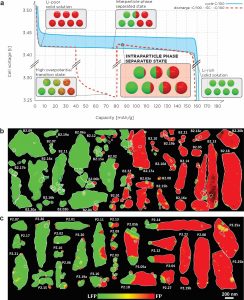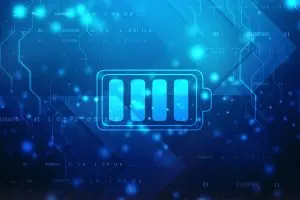Researchers from the Laboratory for Internal Combustion Engines and Electromobility have in collaboration with researchers from the Faculty of Chemistry and Chemical Technology and the National Institute of Chemistry pushed the boundaries of understanding of the electrochemical response of phase-separating battery materials. Based on innovative analytical derivations of the fundamental thermodynamics of materials, electrochemical measurements, advanced microscopy and the advanced simulation models, the electrochemical responses of the intra-particle phase-separated state were discovered and explained for the first time on the example of the LiFePO4 material.
They have namely discovered that the electrode has different chemical potentials and thus also different electrical potentials (Figure), if it is in an intra- or inter-particle separated state at the same state of charge and at the same temperature. As a specific example of entering the intra-particle separated state, they additionally showed that during dynamic operation of the battery it is possible to enter voltage hysteresis (Figure), which was until now considered to be the area in which the battery cannot operate at finite currents. Additionally, they confirmed through innovative experiments and models that these two states are characterized by a significantly different impedance response of the electrode.
These discoveries push the boundaries of understanding of the electrochemistry of phase-separating battery materials and open new pathways for advanced control and diagnostics of batteries as well as virtual sensors, which are targeted breakthrough development areas of battery systems and in which the authors participate in many international projects. The results were published in the recognized journal Advanced materials, which has an impact factor of 32.1.

Figure 1: Different electrochemical responses of the inter- and intra-particle phase separated state and an innovative pulse-based experiment that enables the transition from the inter-particle separated state through the transition state, which is characteristic of high overvoltages, to the intra-particle separated state. STEM-EELS color map showing preferential b inter-particle and c intra-particle phase separation of LiFePO4 material. (Authors: Tomaž Katrašnik, Jože Moškon, Klemen Zelič, Igor Mele, Francisco Ruiz-Zepeda, Miran Gaberšček)
Article is avaliable at: https://doi.org/10.1002/adma.202210937
